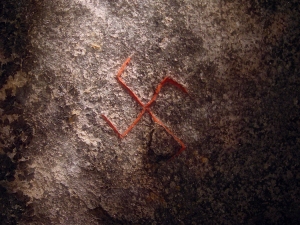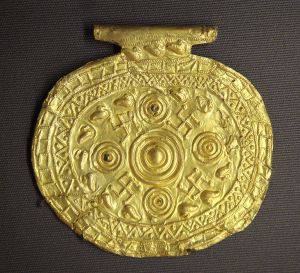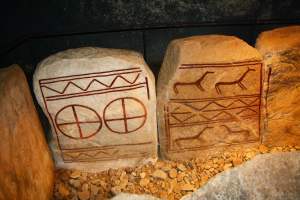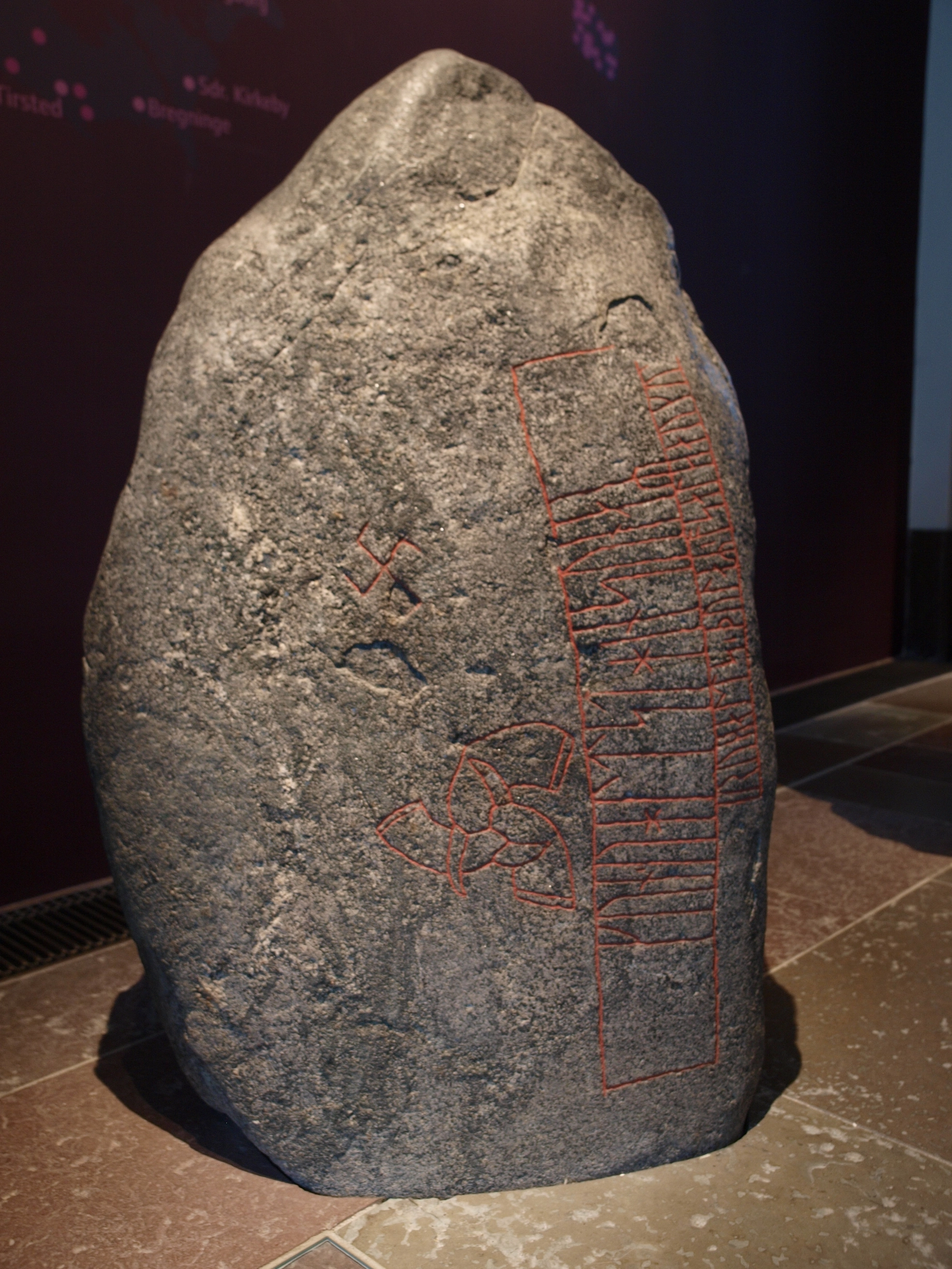
The above is an image of the Snoldelev Rune Stone currently housed at the National Museum of Denmark in Copenhagen; it was taken by Flickr user Mararie on December 27, 2011, and is used with permission. The stone was originally discovered at Snoldelev, Ramsø, Denmark, in 1810, and dates to around the 9th century CE. It is notable for its three interlaced drinking horns in a roughly triskelion design and for its prominent swastika or sun-wheel, shown in detail at right.
You are undoubtedly familiar with the swastika symbol because of its use in Germany in the first half of the 20th century, and various references to that period since. The symbol has a long history dating back to ancient times.

The swastika is so old, in fact, that it is well-known as a symbol of the Proto-Indo-European culture that predated the civilizations who began to keep more or less accurate histories of their lives. A swastika-motif was used in a depiction of a bird on a mammoth tusk dated to 10,000 BCE. Depictions, even ancient ones, have been discovered across continents and across cultures. We have a strong record of its use in the Indus Valley (western India) around 3000 BCE, and the swastika in that culture seems to have been used as a symbol of the sun, infinity, and the birth, death, and rebirth inherent to creation.

Indo-European cultures in general have some similar themes to this ancient use. The swastika seems to be associated with sky gods in general, and seems also to be virtually interchangeable with the sun wheel symbol. It is often used in funerary settings, as a blessing or good luck symbol, and seems to be prominently associated with the greater powers of nature.
In addition to its close association with the sun wheel, in Germanic societies of the Iron Age the swastika is closely related to another symbol: Thor’s hammer Mjölnir. These symbols are all used for blessing monuments, runic inscriptions, and special occasions, and seem to carry much the same significance in many of the contexts of which both symbols are found. The scholar Hilda Ellis-Davidson has taken the swastika inscribed with other runes on a sword found in Sæbø, Vik, Sogn, Norway dating from the Viking age to be an explicit reference to the swastika as a reference to Thor’s hammer.
It seems the swastika symbol was intended much the same as the Mjölnir amulet, the Mjölnir engraving on a monument, or the bind-rune asking Thor to bless a runic inscription. It was a blessing, a good luck charm, and one of many expressions of faith from one branch of an ancient, continents-wide civilization.
So why have you been taught to recoil at the sight of that symbol?
In the nineteenth century, Europe in general and Germanic Europe in particular became fascinated with its ancient, glorious past. This blog and its many illustrations and references to a tradition of scholarship couldn’t exist without that renewed interest in history. One strain of that scholarship in particular focused on the similarities of cultures across Europe and Western Asia, and how many ancestors had worshipped similar gods, used similar words to denote similar things, and so on. We call the ancient culture from which all these similar modern-day cultures seem to descend a Proto-Indo-European culture. Another commonly used term calls the Proto-Indo-Europeans Aryan instead; “Aryan” was originally merely a racial self-designation but also meant something like “noble” or “respectable”. Just as these early studies were relatively innocuous, the term “Aryan” was just a kind word to use to describe one’s ancient ancestors.
As time passed, a great deal of pseudoscience was undertaken to establish that certain of the Indo-European peoples were more closely related culturally (rarely biologically – this was well before DNA testing, after all) to the pure Aryan race of their ancestors, that some peoples had fallen too far from the tree. And in Germany in particular, it was believed that the progenitors of the Proto-Indo-European culture that was seeded throughout Europe and Asia were originally located in the lands that are now called Germany, so the more you look, act, think, and talk like a German, the closer you are to the ancient ancestors. And the closer you are to the ancestors, the better you are as a person.
Of course, this was all foolishness – understanding ourselves and our history is worthwhile, but defining ourselves solely in terms of ancient history is dangerous and is based on a faulty premise, that our ancestors are better than we are.
But the ideas caught on. Because the swastika was prominently featured on many archaeological discoveries of the period, it became a popular good luck charm for those who wished to be associated with this renewed interest in the Aryan race, whether they held innocuous beliefs or supremacist beliefs.

And so when Adolf Hitler’s movement took off, he used the swastika as its central symbol, to indicate his devotion to the idea of racial purity.
His actions and those of his followers resulted in the murder of millions, all in the name of the glory of the Germanic and Aryan ancestors, under the banner of the blessing symbol of the swastika, which is synonymous with expressing devotion to and seeking the blessing of Thor.
Is the swastika permanently stained by the blood spilled under that banner of hatred? Are Thor, Mjölnir, and the sun wheel tainted as well?

The swastika as a part of the historical heritage of Europe and much of Asia can’t really be diminished by Hitler’s actions – we will continue to discover ancient artifacts featuring that symbol for decades, and likely centuries, after the last Nazi is interred. And as a part of Hindu and Buddhist culture, the swastika never acquired the stigma it did in the West, so to some extent, as a symbol similar to how our ancestors understood it, the swastika lives on today. It will undoubtedly continue to be part of Hindu and Buddhist symbology and ritual for years to come.
Whether Thor and the other symbols of sky gods re-establish their sanctity remains to be seen. Neo-Nazi groups continue to use the swastika and some have adopted the sun cross. Some hate groups maintain close associations with paganism and with Norse heathenism, and Mjölnir and Thor. As of the publication of this post, anyway, it’s hard to believe that the stain of racism by so many has been lifted from Thor and his mighty hammer.
But given how prominent Thor has become in our culture, not just in the West, but around the world, it’s easy to see a future coming where the mighty thunderstorm has washed away the stain on his hallowed name. By positive depictions of Thor as a superhero who fights selflessly for humanity, and positive depictions of Mjölnir as an implement that can only be wielded by the very most worthy among us, even those more worthy than Captain America himself, that thunderstorm has already begun. That there exists today a reconstructed heathen faith (Ásatrú) that holds Thor in high esteem and rejects racism (just as ancient believers would have) also speaks well of the future of Thor and his best-known symbol.
Given our painful memories of the swastika and its proximity to so many horrors, it may be a long time before it is able to become synonymous again with Thor and Mjölnir as a positive, hallowed symbol. But we would do well to remember that symbols have power, their meaning can change over time, and have different meanings for different people.

Shatkona and Swastika clashed, how ironical lol
LikeLike
[…] markers, and depending on exactly how it was understood by the pre-Christian Germanic peoples, the swastika may also have been a representation of Mjölnir or Thor’s lightning power, and it, too, was […]
LikeLike
[…] know that some of the interest sparked in the 18th and 19th century resulted in some of the foolish pseudoscientific racialist theories that would eventually lead to Hitler’s National Socialism and the […]
LikeLike
[…] a sun cross, a symbol that predates Christianity and even the Germanic faith, and it and the swastika symbol seem to be related to one another, depicting the sun, a moving chariot wheel, or some other […]
LikeLike
[…] Lovecraft is a keen reminder: not only are people happy to use their northern European ancestry to justify violence and bigotry, but the pre-Christian Germanic society itself included slavery, violence, and inequality that […]
LikeLike